#rayor
Text
tbosas characters as sappho fragments

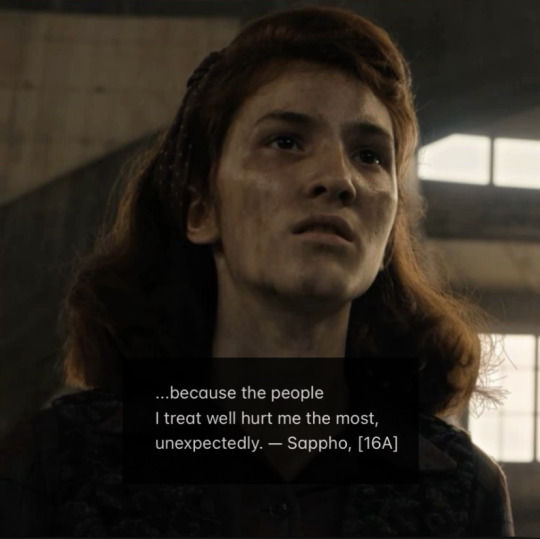
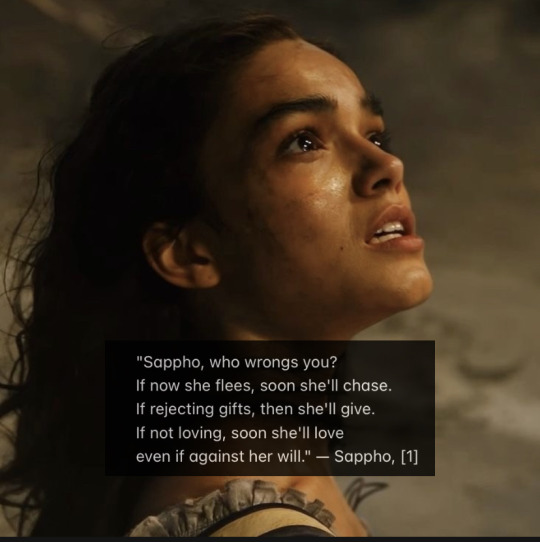






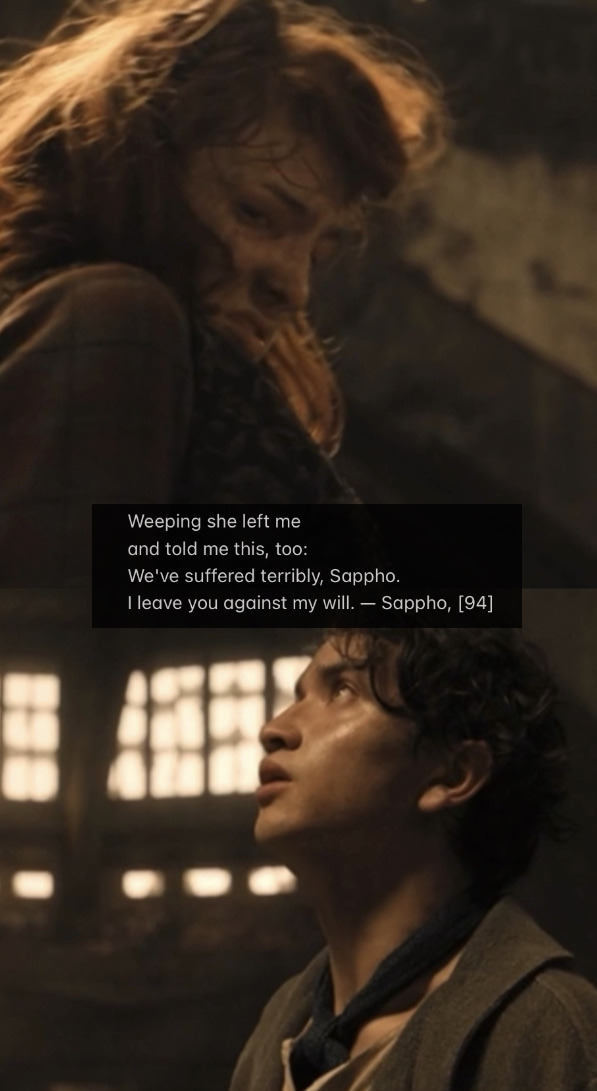
#tbosas#the ballad of songbirds and snakes#sappho#fragments of sappho#my two biggest interests SMASHED#translation by diane j. rayor#coriolanus snow#lamina tbosas#lucy gray baird#coral tbosas#jessup diggs#treech tbosas#sejanus plinth#tigris snow#livia cardew#treemina#the hunger games#thg
90 notes
·
View notes
Text
Come to me from Krete to this holy temple,
here to your sweet apple grove,
altars smoking with
frankincense.
Cold water ripples through apple branches,
the whole place shadowed in roses,
from the murmuring leaves
deep sleep descends.
Where horses graze, the meadow blooms
spring flowers, the winds
breathe softly…
*
Here, Aphrodite, after gathering…
pour into golden cups nectar
lavishly mingled
with joys.
- Sappho, Fragment 2
from Sappho: A New Translation of the Complete Works by Diane Rayor and André Lardinois (Cambridge University Press, 2023)
3 notes
·
View notes
Text

Homeric Hymn to Aphrodite 5, trans. Diane J Rayor.
1 note
·
View note
Text









grief stays in your mouth like sugar gone sour, they won't let you grieve
250 follower celebration | for @sloth-sloth-sloth
diane j. rayor / @vynlets / clementine von radics / rainer maria rilke / sue zhao / @valtsv / mary oliver / @mariihsartt / friedrich nietzsche
taglist (ask to tag!) i am so bad at keeping up with this: @idontreallyexistyet | @routeriver | @sloth-sloth-sloth | @kiwi-smug-silvalina | @fraugustends
#qsmp#jaiden animations#web weaving#tides.ww#idea where jaiden snaps knowing the federation could bring back bobby cuz the feds are dangling his life over hers for whatever reason
68 notes
·
View notes
Text
On your knees

wc: unknown
dom jjk x male reader
cw: face fucking, dumbification, degradation, praise, size kink, possible emetophobia trigger [rayor]
A/N idk i just felt like writing something. it’s not very good but that’s ok lol
“get on your knees” you felt yourself hit the floor, a hand on your shoulder, the one that forced you down. jungkook was looking down at you. he looked angry. he bent down to match the level “do you know why you’re here?” his voice was smooth, low, but the anger was laced throughout his words. “yes sir” you whispered. “are you sure? i don’t think you do.” it wasn’t your fault that guy came up to you and flirted with you at the club, of course it wasn’t, but when jungkook gets like this you can’t help but be extremely turned on. he was so tall standing above you, his eyes were fixed on your body, scanning it, every inch deciding on what to do with you first. at the moment all he wanted to do was mark you.
finally he decided. he slowly started to undo his belt forcing you to stare at his hands as they worked. finally he pulled off his belt and threw it to the floor. you were getting restless, needy. you knew what was coming next. jungkook pulled down his pants releasing his cock. you’ve seen it a thousand times but it’s size always shocked you. he was huge and he knew it. grabbing your head he forced your mouth on to his cock. you felt him go down your throat, usually you could handle it but the force was different. jungkook held your head in place, starting to thrust into your mouth. each time he thrust into you jungkook grunted. his pace quickened, very fast. it started to feel like he was tearing your throat open. tears started rush down your face landing on the floor mixing with your saliva. he was moving so fast, fucking your face like a fleshlight. you hands were trying so hard to keep yourself steady which was barely possible due too his relentless use of your poor mouth.
you looked so pretty to jungkook. his cock being squeezed by your throat was driving his dick insane. he flexed making you choke. he smirked, what a whore, a cock hungry slut taking his whole length down your small throat. he knew how much you loved having your mouth destroyed by him so he wasn’t going to hold back on you.
he thrust into your mouth one last time before pulling his dripping cock out. his dick was hanging in-front of your face, so heavy and perfect. you wanted more. you blinked once before a warm sensation graced your wrists. jungkook was tying you up with his favourite rope. jungkook tightened the rope around your wrists forcing a whimper to escape your pretty cock slut lips.
he brought you over to the side of the bed forcing you down onto your knees once again. he then took your hands and held them over your head, he didn’t want you to do anything you’d regret. his pants were covered in your saliva and precum, it was so incredible hot. once again he brought his cock to your lips teasing you, brushing the tip against your lips. you tired to move your head forward to get even an inch into your sore mouth. you felt a smack hit the side of your face followed by a warm sting. “bad boy” jungkook hissed. you pouted in response. the heat from the hit was dying down sending a shiver down your spine. once again jungkook forced himself into your mouth and down your throat. the sensation of the whole length of his dick hitting the walls of your throat made you numb. it hurt but it felt way to good for that to matter.
jungkook smirked. the longer he face fucked his cute little whore the more he knew you wouldn’t think about anything else. he was marking you, the bruises in your mouth were to be evidence of it, that and the fact you’d be a stupid babbling mess after he was done with you.
your brain was numb and full of endorphines the strain your underwear had on your dick was only adding to the fact that the mere sensation of jungkook using your mouth was already pushing you closer to the edge. you were such a whore, getting off to the mere sensation of jungkook thrusting himself inside you. you felt your dick twitch followed by the euphoric sensation of an orgasm flooding your body leaving your dick sensitive overstimulating you as it touched your now cum soaked underwear.
“how pathetic” jungkook growled “you came because of my dick down your throat?” he pushed his dick deep down as far as he could. he felt his orgasm reach its edge and collapse in a second. cum flooded your stomach like a damn collapse. he kept thrusting into you making sure you took every drop of him. as he pulled out of your mouth cum was still leaking ok of him, giving you the much desired taste you were longing for. “good boy” jungkook spoke in a whisper giving you a kiss on your mouth. he could taste his cum on your lips.
now you knew who you belonged to
335 notes
·
View notes
Text
I’ve been reading If Not, Winter: Fragments of Sappho, a translation of Sappho’s poetry by Anne Carson, and last night came upon one I had been VERY curious about how she would approach:

The book. Fragment 102. On the left, two lines of Greek text:
Γλύκηα μᾶτερ, οὔ τοι δύναμαι κρέκην τὸν ἴστον
πόθῳ δάμεισα παῖδος βραδίναν δι’ Ἀφροδίταν.
And on the right, Anne Carson’s translation:
sweet mother I cannot work the loom
I am broken with longing for a boy by slender Aphrodite
I, of course, being Too Online that I am, am more familiar with this translation, by Diane J. Rayor:
Sweet mother, I cannot weave–
slender Aphrodite has overcome me
with longing for a girl.
So of course I wondered, What Is The Truth? Anne Carson provides lots of end-notes on word usage and historical context, but was fully and uncharacteristically silent on this one.
When looking into it, the word Sappho used for the object of her longing is παῖδος, paîdos, which is most commonly translated as “youth” because it’s not gendered. It can mean either a boy or a girl.
So, whether Sappho is overcome by Aphrodite with longing for a boy or for a girl is, in fact, translator’s choice. (There are reasons besides heteronormative assumptions for translating it as “boy”—though the word is not gendered, it’s cognate with a lot of words like puer that mean “son” so may have had a more masculine-as-default assumption (like a lot of European languages do), and when Sappho wrote about young women, the word she commonly used was παρθένος parthénos “young woman, maiden, virgin.” But paîs/paîdos it is not a gendered word and could be translated either way!)
And honestly now I appreciate the cleverness of ones who find workarounds to avoid gendering the one she’s longing for, to be more honest to what she actually wrote.
#If Not; Winter is Pretty Gay. Sappho's poetry is very frequently Pretty Gay. But history is never quite so cleanly one thing or another#poetry#Sappho#If Not Winter#Anne Carson#translation#tagamemnon
262 notes
·
View notes
Note
Hi! Sorry to bother you but I was hoping you could help me with something. I was wondering how you would translate Sappho fragment 50 (Voigt)
ὀ μὲν γὰρ κάλος ὄσσον ἴδην πέλεται ⟨καλος⟩,
ὀ δὲ κἄγαθος αὔτικα καὶ κάλος ἔσσεται.
I know that Carson translates it to "For the man who is beautiful is beautiful to see but the good man will at once also beautiful be." (Rayor will say handsome man instead of beautiful man). But is this translation 'correct' in that the words beautiful and noble refer to a man in particular? I thought the fragment was about beauty and nobleness in general, not about a singular subject?
But of course, I could be 100% wrong which is why I'm asking haha
yes, you can tell from the article and ending of kalos (both masculine) that the fragment is about a man. also, "kalos kagathos" (beautiful/noble and good) was a popular cliche in ancient greece describing the ideal man.
never hurts to question translations, though! :)
33 notes
·
View notes
Text
🍋 😈NSFW...fuck triggers I'm not giving any RAYOR!!!
I could only think of cockwarming, edging, and slowly fucking Chosito in your chair while you bent over his thick tittied chesticles and started a chest piece to display the beauty of his curse.

The buzzing of the tattoo gun was drowned out by the reverb from the base of the music. The screaming and haunting vocals mixed wonderfully with the hissing and deep guttural moaning that came from the man beneath you.
The way his hair framing his face stuck to the perspiration from the mix of pain and pleasure. His lips were swollen from eating your pussy out before the appointment. God the way he bit his lip and pathetically failed at keeping quiet as you softly rolled your hips.
Fuck the way he throbbed within your gummy walls while you were busy made your nostrils flare before you sat up and bounced softly on him to make your creamy center froth around him. Bringing him to the edge and stopping to grind against him for some friction before waiting to bend back over to return to your line work.
You'd clench around his girth and watch him ball his fists staying stock still for you. His thighs shaking as he tried to move his hips just right to bury himself deeper. You'd have to tsk and sit up again and tease him before reaching up to slap him and grab his face to make him focus on you.
Dark endless ochre eyes swirling with desire and overstimulation. He begged to let him fuck you...whined like a perfectly submissive bitch...fuck you'd let him come once the color was done. You were having to much fun feeling him get harder inside of you and hit every spot inside...
#husbando#jujutsu kaisen#jjk smut#jjk choso#chosito#Human Canvas Choso#choso kamo#tw. cockwarming#tw.edging#tw.slapping#tw.stigmatophilia#tw.subbychosito#tw.RAYOR#tw.🍋#Spotify
30 notes
·
View notes
Text
Offerings in Hellenic Polytheism
┏━━━━━━༻❁༺━━━━━━┓
TABLE OF CONTENTS
i. Introduction
ii. Animal Sacrifice
iii. First Fruits
iv. Dedications
v. Libations
vi. Conclusion
┗━━━━━━༻❁༺━━━━━━┛
TW: Animal Sacrifice
───────
Disclaimer
While I have read about this subject and have tried to provide accurate information, I do not have any sort of post-secondary education on the subject. I encourage those reading this post to also do their own research, books cited in my sources are a good place to start. I also encourage people reading to correct me if I make any mistakes.
───────
Introduction
─━━━━━━⊱༻ ༺⊰━━━━━━─
Offerings and sacrifice are one of the central religious acts of Hellenic Polytheism. It is how we build kharis (reciprocity, grace, and favour) with the gods. It is important to know how and what to offer to the gods.
Offering and sacrifice almost always involved two things other than the offering; an altar and fire. There were two categories of altar for different purposes. The bômos, a high stone altar with a flat surface for ouranic deities, and the bothros, a shallow pit, dug into the earth for khthonic deities.
Fire is something that is found in almost every offering and cult activity in ancient Greece. It is important to note that because of the association with hearths and altars, Hestia takes part in all sacrifices and offerings. This is noted in the Homeric Hymn To Aphrodite:
Hestia rests at the hearth, the highest honor.
All people revere her in every temple,
Hestia, the most august of the gods.
- Homeric Hymn 5, translated by Diane J Rayor
Offering and sacrifices made towards ouranic deities were made preferably before noon in daylight, while offerings made for khthonic deities were done at night.
When making sacrifices and offerings, worshipers would wash themselves, dress in white, clean clothing, and adorn their heads in wreaths and garland.
Offerings always were accompanied by a request. This request could be for health, crop growth, ect. or just for the god(s) to accept the offering. My blog on Prayer in Hellenic Polytheism discusses this in more detail.
───────

Hestia Giustiniani, Marble, Second Century C.E. Roman Copy
Image Source
───────
Animal Sacrifice
─━━━━━━⊱༻ ༺⊰━━━━━━─
Animal sacrifice was one of the most common forms of offering found in ancient Greece. Many types of animals were sacrificed. Sheep were the most common, with goats and pigs in second and third place. The second most expensive were pigs, while piglets were the cheapest. Oxen, notably bulls, were considered the most honourable and the most expensive. Poultry also had a common place in sacrifice as well.
Domesticated animals were a part of animal sacrifice exponentially more than wild animals were. In the case of the sanctuary of Artemis at Kalapodi, there have been bones of deer and boars found.
It was important that the animal being sacrificed was healthy, well taken care of, and undamaged. The only place in ancient Greece that we know of that commonly had cheaper, smaller, and mutilated sacrificial animals was Sparta. The head and stomach of the sacrificial animal was decorated in garlands and ribbons. In some cases, the horns of bulls were covered in gold.
The colour of the animal was another important aspect of sacrifice. In the case of ouranic deities, the animal(s) would be white, and for khthonic deities, they would be black. The sex of the animal was also lined up with the gender of the god or goddess, though there have been exceptions.
There was a sequence of events when sacrificing an animal. This sequence starts with the procession that escorts the animal to the altar, the pompê. The pompê was headed by an aristocratic girl who carries a basket on her head, filled with barley groats and cakes that cover a sacrificial knife. The animal was guided by adolescent boys. A piper, who could be male or female, played music alongside the procession. Following behind were adult men and women. A vessel containing lustral water is brought along, and sometimes an incense burner.
Once they reached the altar, they stood in a semi-circle, with the altar in the front and the naos (temple) in the back. The basket and the water vessel are walked counterclockwise around the altar. The worshipers then have water poured over their hands, sprinkled on the altar, and sacrificial animal. This part is called the archesthai. It was important for the animal to be seen as willing, so the water sprinkled on its head created a nodding gesture, indicating acceptance. Everyone then grabs barley groats, called oulai, and while a prayer is recited, the barley is thrown at the altar and sacrificial animal. This part is called the katarchesthai.
Right before the animal is sacrificed, hairs are cut from its head and thrown into the fire. If it was an ox, it would be stunned with an axe. The animal's head is held up, and its throat cut. Once the animal bled, the women there would cry out. This part is called the ololygē. The blood was either directly poured on the altar in the case of smaller animals or collected in a bowl and then poured; none of it hit the ground. This part is called the haimassein.
The animal is skinned, which goes to the priest or sanctuary. The thigh bones are separated from the body, the meat is removed, and the bone is wrapped in fat. The thigh bones and small pieces from each limb placed on top are burned. The gallbladder and tail could also be a part of the sacrifice, though later they were specifically used for divination. The splanchna (kidneys, liver, spleen, and probably heart and lungs) is then roasted on the fire and are first to be eaten. A libation of mixed wine is then poured over the fire. Lastly, the meat is prepared, roasted or boiled, distributed, and eaten in a feast. The quality of the meat was distributed based on rank and social status.
In certain circumstances, the animal wasn’t eaten and instead burned whole. This was called a holocaust offering. The worshipers, in this case, would not partake in the sacrifice at all, so there is no feast. Holocaust sacrifices were specific to khthonic deities and the dead. Though still, there have been exceptions where a feast takes place.
───────
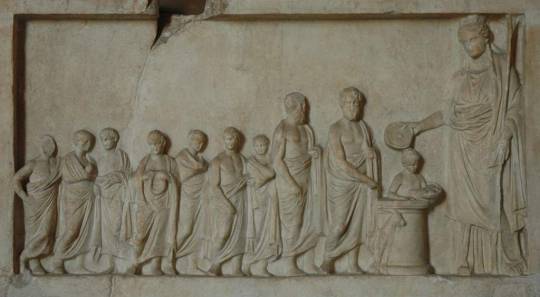
Marble Votive Relief, 340-320 B.C.E.
Image Source
───────
First Fruits
─━━━━━━⊱༻ ༺⊰━━━━━━─
First fruits referred to the offering of the first of the spoils acquired through hunting, fishing, gathering, and farming. This could be many things from figs, olives, and grapes to bread, milk, and wool. These offerings were placed at the altar, sacred site, or left in bodies of water, for the animals in the area. First fruit offerings gave what the season had to offer.
These types of offerings were popular with more rural deities such as Pan or the nymphai, as well as agricultural deities such as Demeter and Dionysos. The first fruits of many crops are given to corresponding deities when they are harvested.
Panspermia was a common type of first fruit offering found at many festivals. It was a mixture of different fruits and grains that were occasionally cooked in a pot.
These types of offerings in ancient Greece often accompanied animal sacrifice but were still at times done by themselves.
───────
Dedications
─━━━━━━⊱༻ ༺⊰━━━━━━─
There are two types of dedications that can be made: votive offerings and thank offerings. Votive offerings are any offerings made in the result of a vow, a dedication. Thank offerings were made in gratitude for help from a god in a worshipers life. Votive and thank offerings can include many things: first fruits, animal sacrifice, libations, but most interestingly statues, vases, clothing, tools, equipment, and even altars and temples.
Statues would have inscription on them documenting who gave the offering, and which god it was made too. Statue votives could also be bought or made by the worshipper themselves.
One form of votive was how, during wartime, soldiers would vow to dedicate the shields and weapons of their enemies for success in battle. An example of a thank offering is how when people reached old age and retired, they would dedicate their work tools and equipment to the related god's sanctuary.
Hair offerings were a form of dedication made during writes of passage. For boys, it was done when they reached adulthood and for girls when they got married. The cut hair was then offered to a god, river god, or hero.
Votive and thank offerings were commonly made to the god Asklepios in many of his temples. These offerings were sculpted body parts called anatomical votives. These were offered to give thanks or as a request for the god to heal the affliction affecting that part of the body.
Dedications were usually left in a sanctuary. Once these objects were dedicated to a god, they couldn't be taken back or leave the sanctuary. They are now property of the god or goddess.
───────
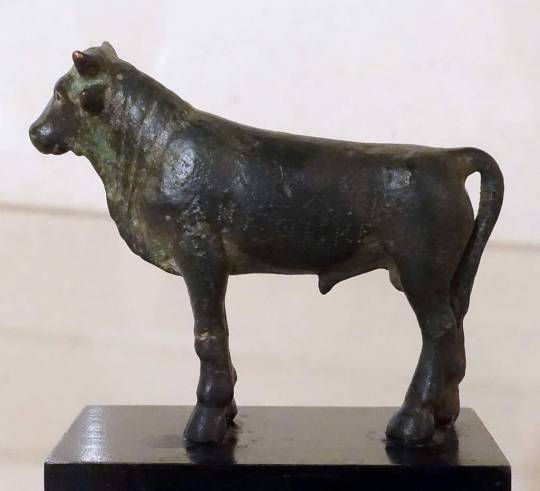
Bronze Votive Bull, Sanctuary of Zeus, Nemea, 400-350 BC
Image Source
───────
Libations
─━━━━━━⊱༻ ༺⊰━━━━━━─
Libations are liquid offerings poured for the gods and were the second most common forms of offerings in ancient Greece. They were typically poured out of a vessel called a phiale, which is a round bowl. Libations were shown on Athenian vases being poured with the right hand holding the phiale. Libations were directly poured onto the bômos or bothros.
There are two different types of libations found in ancient Greece: sponde and choe. Spondai were most commonly made to the Ouranic gods and had wine as the main liquid. The pouring of the sponde was done with a bowl or hand-held vessel, and the flow of the liquid was controlled. Choai were made for Khthonic deities and primarily had oil, milk, water, and honey as their main liquids. A choe was spilled and emptied from a large vessel into the earth; it was uncontrolled compared to a sponde libation.
Though wine was most common with sponde and milk, oil, and honey with choe, there were still instances where the liquids were used in the opposite type of libation.
Whenever people in ancient Greece would drink wine, a sponde was performed. In symposia, the first libation was offered to Zeus and the Olympians, the second to the heroes, and the third to Zeus Teleios (the finisher). The Agathos Daimon and Hermes were second and third libations in other instances. After, anyone can invoke and pour a libation to other gods.
───────
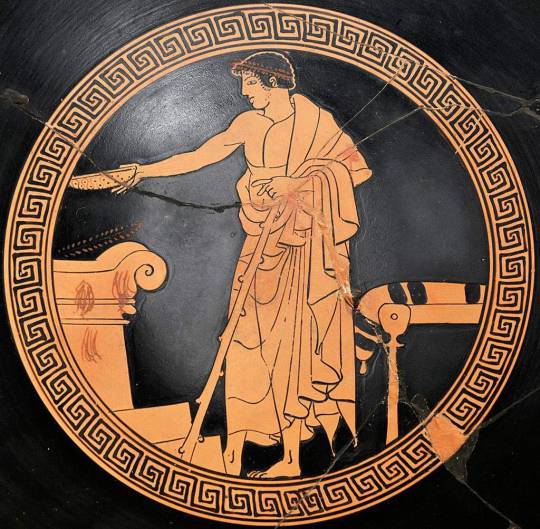
Attic red-figure cup, 480 B.C.E.
Image Source ]
───────
Conclusion
─━━━━━━⊱༻ ༺⊰━━━━━━─
Of course, animal sacrifice is often out of the question for most Hellenic Polytheists, whether that be due to circumstance or personal views. This means that when it comes to offerings made to deities, we must focus on other types that are more accessible to us.
I might also do a blog on why sacrifices and offerings are done as this blog explains more the act.
I think be doing a blog on altars and temples next. So, if you’re disappointed at the amount of information about altars here, there’ll be more coming soon.
Sources:
Greek Religion by Walter Burkert, 'Working Sacred Things' Animal Sacrifice and Gift Offerings and Libations
A Companion to Greek Religion by Daniel Ogden, Greek Normative Animal Sacrifice
Smokes Signals for the Gods by F. S. Naiden
Ancient Greek Religion by Jon D. Mikalson, An Overview: Greek Sanctuaries and Worship and Greek Gods, Heroes, and Polytheism
Theoi & Khlaire & Magpie
#witch#herbal magick#witch blog#kitchen witch#hearth witch#pagan#herbs#kitchen witchery#green witch#witchcraft#hellenic polytheist#hellenic polytheism#hellenic#hellenic community#hellenic witch#hellenic polytheistic#hellenism#hellenic deities#hellenistic#hestia#hestia goddess#greek deities#greek gods
47 notes
·
View notes
Text
…I will love [you]
…as long as [breath] is in me
Sappho - 'Sappho: A New Translation of the Complete Works,' translation Diane Rayor
6 notes
·
View notes
Text
category five sappho moment (reading the rayor translation for the first time)
8 notes
·
View notes
Text
Sweet mother, I cannot weave –
slender Aphrodite has overcome me
with longing for a girl.
-Sappho, from fragment 102 of Sappho: A New Translation of the Complete Works, trans. Diane Rayor
2 notes
·
View notes
Text
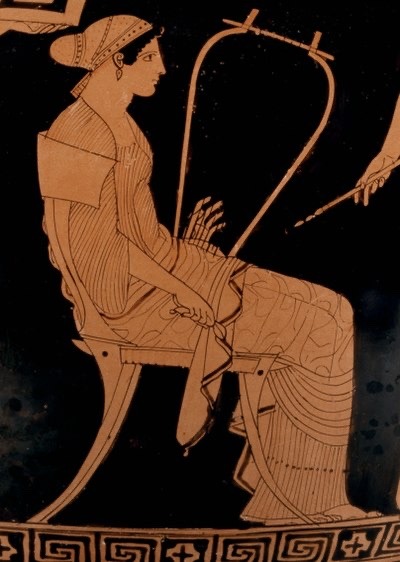
ὔμμες πεδὰ Μοίσαν ἰ]ο̣κ[ό]λ̣πων κάλα δῶρα, παῖδες,
σπουδάσδετε καὶ τὰ]ν̣ φιλάοιδον λιγύραν χελύνναν·
ἔμοι δ’ ἄπαλον πρίν] π̣οτ̣’ [ἔ]ο̣ντα χρόα γῆρας ἤδη
ἐπέλλαβε, λεῦκαι δ’ ἐγ]ένοντο τρίχες ἐκ μελαίναν·
The Muses, scattering violets from their skirts,
bring lovely gifts: children, be quick to seize them;
reach for the high-tuned lyre,
companion to our songs.
(Fragment 58a, trans. by Spraggs)
ἄγι δὴ χέλυ δῖα μοι λέγε
φωνάεσσα δὲ γίνεο
Come, divine lyre, speak to me and sing!
(Fragment 118, trans. by Rayor)
15 notes
·
View notes
Note
I noticed you seem to like the same sort of books as I do, are there any books that you think everyone should read, or that you really loved?
I've started to answer this three times but kept getting stuck on what books to include. There's just so many I love and I end up free associating through a ton of different books and have trouble narrowing it down to anything resembling a reasonably short list.
Like, I'll think of recommending Ulysses (difficult in parts but if you can get through the third episode Prosteus the next ten episodes are a lot easier and the shifts in style and allusions and it's structure are so much more fun than it's stuffy academic reputation would have you think. I'd recommend avoid relying overmuch on annotations/a guide if reading for the first time unless you feel extremely lost) and then for obvious reasons I jump to the Odyssey (I like the Wilson translation) and from the Odyssey my mind goes in two directions to Terra Ignota (a fascinating recently completed SF series set in the 24th century where non-geographical voluntarily joined "hives" have replaced nations states as the primary unit of political organization and the book is framed as an in universe history which the narrator is composing in the style of an eighteenth century writer) and Sappho (beautiful poetry albeit largely only preserved in fragments, Carson's If Not Winter is the most popular translation but lacks recent finds as new poems have been discovered since it was published. I think Diane Rayor's 2014 collection is still the most comprehensive translation in English and has great notes but is expensive if you're paying for it instead of acquiring it using other methods) and so on and so on.
If you (or anyone else reading) was looking for a more specific type of recommendation feel free to send an ask! I always welcome an opportunity to talk about books I love. Otherwise I hope some of the above books caught your eye.
(I also responded to an ask meme recently about my top 5 (actually 6) books I read in 2023 which may be of interest)
5 notes
·
View notes
Note
oh my god that post about that sappho Aphrodite quote, I've seen so many people use that quote to be biphobic assholes and you're telling me it's a translation choice, i am biting biting biting biting biting
Ohhh jeez, I'm sorry, I didn't realize it had been used that way. (I was a little bit aware of the ways that the back-and-forth over whether Sappho was "really a lesbian" or "really bisexual" can get nasty and cruel, but I had no idea that poem-fragment had been used as evidence to be biphobic about it.)
There are many poems that seem to be very explicit about love for women; there are many poems about young women and their beauty, their grace, the way their love leaves the narrator shaken. (I have an earlier post where I was taken aback at how genuinely gay the poems came off.) Fragment 31, for example, has been recognized as "oh she is in love with that women" since the 1700s. However, there do appear to be some poems about men, and some scholars also think she had a daughter named Kleis, though whether the person addressed as Kleis is actually her daughter is debated. It's also important to note that her poems cannot be assumed to all have been her own personal innermost thoughts of her own experience - some (likely a lot of them!) were composed to be performed at weddings or banquets, or by choruses of young women at festivals.
Very little is known about her life for sure, because for two thousand years people have been arguing about her sexuality. No, really. It's also a very important point that in 600 BC Greece, understandings of how attraction correlated to action correlated to identity were not the same as ours. Her love for women seems very much to come through in the poetry; any group trying to unequivocally and unilaterally "claim" her isn't engaging with the context of history, and is unfairly ostracizing real, living, sapphic women now.
But ALSO however there is a history of translating Sappho's love poetry with the assumptions of straightness. So the fascinating thing, to me, about the "longing for a girl / longing for a boy" poem is how, throughout history, it has been very common to translate paidos as "boy." So Diane Rayor, translating it as "girl," is not doing so neutrally but very pointedly and deliberately, saying that, this word could mean a boy. It could also mean a girl. My translation is equally as real as yours, because both are making a choice. It challenges us to think about translation choices, why we make the assumptions we do. Its power is in its context. And passing it around the internet as unbiased and contextless is doing Sappho, Rayor, and honestly, everyone, a disservice, in my opinion.
I'm sorry if it's been used against you.
21 notes
·
View notes
Text
Come to me from Krete to this holy temple,
here to your sweet apple grove,
altars smoking with
frankincense.
Cold water ripples through apple branches,
the whole place shadowed in roses,
from the murmuring leaves
deep sleep descends.
Where horses graze, the meadow blooms
spring flowers, the winds
breathe softly…
*
Here, Aphrodite, after gathering…
pour into golden cups nectar
lavishly mingled
with joys.
- Sappho, Fragment 2 from Sappho: A New Translation of the Complete Works by Diane Rayor and André Lardinois (Cambridge University Press, 2023)
6 notes
·
View notes